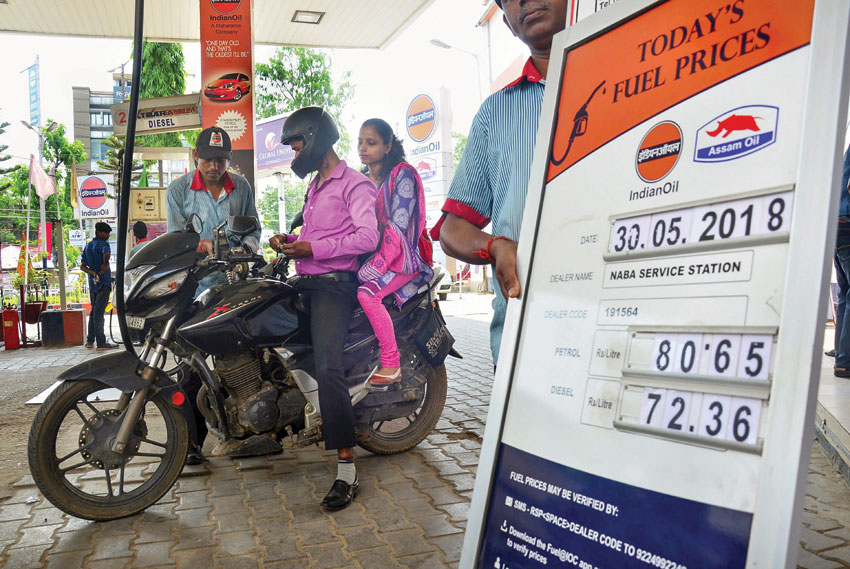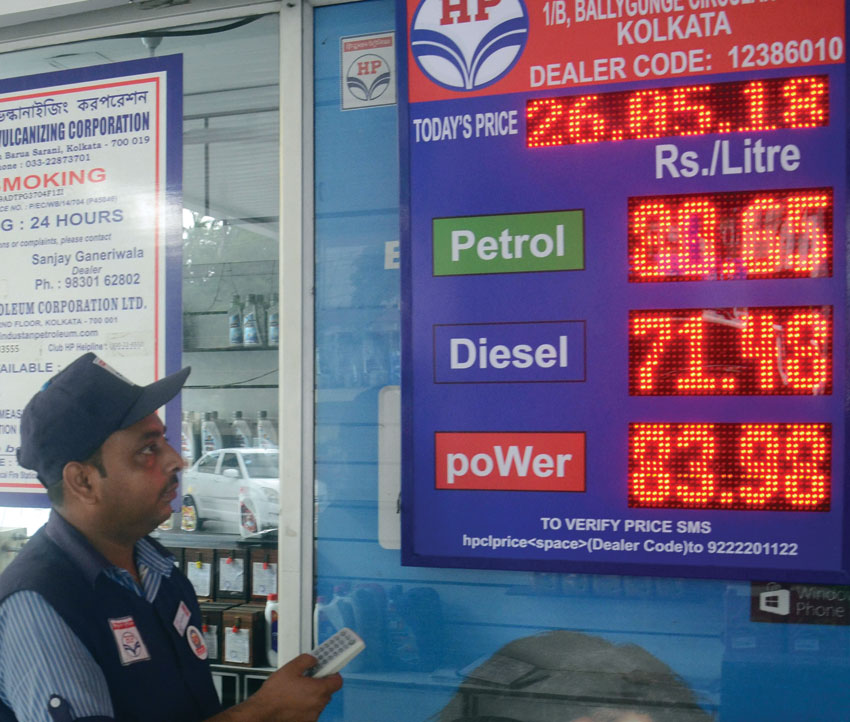Modi Government Faces Biggest Policy Dilemma
An employee sets the fuel prices on a display boards at a gas station, as the fuel prices remain at record high levels, in Kolkata, May 26. (Press Trust of India)
Petrol (Gasoline) and diesel prices are quoting all-time record highs in India due to rise in international crude oil prices and refusal of federal and state governments to cut steep duties in the form of excise, value added tax (VAT), cesses and royalties. On May 26, domestic petrol prices increased for the 13th day in a row, to quote nearly Rs. 78 per liter. In Mumbai and Chennai, petrol was priced over Rs. 85.8 and nearly Rs. 81 per liter, respectively. Diesel prices, also at all-time highs, are quoting between Rs. 69 and Rs. 74 per liter across major cities in the country, writes Siddharth Srivastava.
The U.S. Energy Information Administration has said current fuel prices in India are the fourth highest among the top 10 crude oil consuming nations in the world. With prices hiked for 15th day in a row on May 28 and clamor rising to buffer the impact on consumer, minister of oil and natural gas Dharmendra Pradhan said the government is planning a “holistic strategy” to find a “long-term solution,” to the rate spike without specifying the exact way forward.
Last month, road transport and highways minister Nitin Gadkari advocated bringing of petrol and diesel under the Goods and Services Tax (GST) framework. “This will not only reduce fuel prices but also increase the government’s revenue,” the minister said. Similar comments have been made by Pradhan in the past. Rajiv Kumar, vice chairman NITI Aayog, the official policy think tank, also said both states and the center should reduce taxes. The refusal to reduce taxes, however, are centered around matters that go beyond financial arithmetic. Having promised massive social welfare schemes such as free cooking gas, medical and insurance benefits, road infrastructure and electricity for all, New Delhi is averse to any failure due to lack of finances. Any political backlash can affect results of general elections due next summer.

Burdening ONGC
There are suggestions the government may junk free and dynamic market pricing of fuels and re-introduce the old model of subsidizing state-owned oil marketing companies (OMCs) for selling petrol and diesel below cost price. Under this paradigm, the three OMC’s Hindustan Petroleum Corp (HPCL), Bharat Petroleum Corp (BPCL) and Indian Oil Corp (IOC) under-recoveries will again be doled by state entities including GAIL, Oil India Limited (OIL), with the bulk of burden heaped on explorer and oil and gas producer Oil & Natural Gas Corp (ONGC). News agency PTI reported, quoting unnamed sources, that New Delhi may levy a windfall tax on ONGC as part of solution to moderate spiraling fuel prices.
Under the scheme, oil producers that get paid global rates for the oil they produce from domestic fields, would have to part with revenue earned once oil prices crosses the $70 per barrel mark. The report further added that the cess may be imposed on both private and public-sector explorers to ensure a fair-playing field for all companies. This, however, will not be easy as the move will certainly be opposed by private players who will resort to judicial intervention. A similar tax proposed in 2008 was shelved due to stiff opposition by private entity Cairn India.
There is also much less flexibility the government has now to play around with ONGC’s finances that are stretched due to expensive acquisitions and massive capex plans to raise oil and gas production even as profits have declined. ONGC’s capex nearly trebled in 2017-18 to Rs. 720 billion, most of which was spent on acquiring government’s majority stake in HPCL and Gujarat State Petroleum Corporation (GSPC’s) gas field in the offshore Krishna Godavari (KG) Basin. ONGC, debt-free for decades, had to borrow about Rs. 250 billion to acquire HPCL.
ONGC has also drawn up a blueprint to raise crude oil production by four MT and double natural gas output to over 100 MMSCMD by 2022. Key to achieving the aims set will be success at KG-DWN-98/2 or KG-D5 where ONGC is investing $10 billion. In ongoing fiscal year 2018-19, ONGC has said it will invest over Rs 176 billion to drill a record 535 wells.
Policy Dilemma
Fuel pricing is one of the biggest policy dilemma the incumbent government led by Prime Minister Narendra Modi faces. Balancing high fuel costs that impact the middle-class consumers and rising aspirations of the rural poor that expect the government to deliver on its much-publicized social welfare schemes will not be easy to manage.
Thankfully, New Delhi has so far not taken the easy route of making state oil companies subsidize fuel sales that will impact their bottom lines and ability to invest. At the same time, the almost three-weeks freeze in oil price hikes leading to Karnataka elections is indication that New Delhi is not averse to taking the politically expedient route. There is also talk that New Delhi is biding its time in the belief that current high crude oil price levels are not sustainable and the rates will soon drop.


